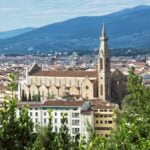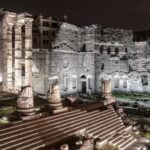Italy is a country renowned for its rich culinary traditions and breathtaking landscapes. But it is also home to some of the world’s finest wines, making it a dream destination for wine enthusiasts.
In this article, we will delve into the wonderful world of wine travel in Italy and uncover the hidden gems that await exploration. From centuries-old wine traditions to world-renowned vineyards, we will take you on a journey through the diverse and captivating wine regions of Italy.
Italian wine regions have a unique allure that sets them apart from the rest. From Tuscany to Sicily, each region boasts its own distinct flavors and characteristics.
By immersing yourself in these centuries-old traditions, you’ll be able to truly appreciate the artistry behind winemaking in Italy. Whether it’s exploring historic wineries and cellars in Montalcino or savoring the volcanic wines produced on the slopes of Mount Etna, each region offers a unique experience that will leave a lasting impression.
Embarking on a wine travel adventure in Italy means embarking on a journey to explore the finest vineyards in the country. Whether you’re an experienced oenophile or simply someone who appreciates good wine, Italy has something to offer for everyone. From Barolo, known as the King of Italian Wines, to Franciacorta’s sparkling wonders reminiscent of Champagne, each destination promises an unforgettable experience filled with tastings of exquisite wines and indulgence in delicious food pairings.
Join us as we uncover the hidden gems of Italian wine travel and guide you through the enchanting vineyards of Tuscany, explore Piedmont’s land of Nebbiolo and truffles, discover the sparkling wonders of Franciacorta, experience Sicily’s volcanic terroir on Mount Etna, sip crisp whites along the Amalfi Coast, unveil Umbria’s hidden wine gem, and delve into Italy’s ancient Roman wine culture.
Get ready to plan your own unforgettable wine travel adventure in Italy, and prepare to be captivated by the vibrant flavors and unmatched beauty of this extraordinary country.
The Enchanting Vineyards of Tuscany
Italy’s Tuscany region is a wine lover’s paradise, offering enchanting vineyards and a rich wine history. When exploring Tuscany’s wine regions, one cannot miss the world-renowned Chianti region. Known for its exceptional red wines, Chianti offers breathtaking landscapes and picturesque vineyards. Visitors can embark on tours and tastings at historic wineries, where they can learn about the winemaking process and discover the distinct flavors of Chianti wines.
Another must-visit destination in Tuscany is Montalcino, home to prestigious wineries and cellars. Here, wine enthusiasts have the opportunity to savor the unique flavors of Brunello di Montalcino, a revered red wine made from Sangiovese grapes. Taking a tour of the wineries in Montalcino allows visitors to witness firsthand the meticulous care that goes into producing these exceptional wines.
The Val d’Orcia wine region is also not to be missed when exploring Tuscany. This UNESCO World Heritage site offers stunning views of rolling hills dotted with vineyards and charming medieval villages. The wines produced in this region are known for their elegance and finesse. Visitors can take guided tours of family-owned wineries, where they can indulge in tastings while taking in the beauty of the surrounding countryside.
To make the most of a wine lover’s paradise in Tuscany, it is recommended to create an itinerary that includes visits to renowned regions such as Chianti, Montalcino, and Val d’Orcia. Whether it is exploring historic wineries or immersing oneself in the picturesque landscapes, Tuscany offers an enchanting experience for all wine enthusiasts.
Notable Destinations
- Chianti region
- Montalcino
- Val d’Orcia
Activities
- Guided tours of historic wineries in Chianti
- Tastings of Brunello di Montalcino wines in Montalcino
- Exploration of vineyards and countryside in Val d’Orcia
Tips for Visitors
- Plan ahead and make reservations for winery tours and tastings
- Consider hiring a local guide who can provide insights into the region’s wine culture
- Sample local cuisine alongside wine to fully appreciate the flavors
Embarking on a wine adventure in Tuscany promises to be an unforgettable experience filled with exceptional wines, breathtaking landscapes, and centuries-old traditions.
Piedmont
Piedmont, located in the northwest of Italy, is a wine lover’s paradise offering a blend of rich wines and exquisite gastronomy. The region is renowned for producing some of Italy’s finest wines, including the beloved Nebbiolo grape varietal. In addition to its world-class wines, Piedmont is also known for its famous white truffles, making it a true culinary delight for travelers.
A must-visit destination in Piedmont is the prestigious Barolo wine region. Known as the “King of Italian Wines,” Barolo offers a remarkable experience for wine enthusiasts. Here, visitors can take tours of vineyards and wineries that have been producing Barolo wines for generations. The picturesque landscapes and rolling hills provide a stunning backdrop as you learn about the meticulous winemaking process and taste these highly sought-after wines.
Another gem in Piedmont’s wine scene is Barbaresco. This neighboring region to Barolo produces equally impressive wines made from Nebbiolo grapes. Visiting here offers an opportunity to explore historic vineyards and experience the unique microclimates that contribute to Barbaresco’s distinctive character. Don’t miss out on tasting this velvety red wine with its notes of dried cherries, violets, and spices.
Beyond its wines, Piedmont is also famous for its truffles, particularly white truffles found in the city of Alba. Every fall, Alba hosts the International White Truffle Fair where visitors can immerse themselves in this aromatic delicacy. Walking through the bustling streets filled with vendors offering an array of truffle-infused products is truly an unforgettable experience.
The Sparkling Wonders of Franciacorta
The sparkling wonders of Franciacorta have long been hailed as Italy’s answer to Champagne. Situated in the Lombardy region, this wine-growing area is renowned for its exceptional sparkling wines that rival the finest bubbles produced in France. With its unique microclimate and terroir, Franciacorta has become a destination for wine lovers seeking a taste of Italian excellence in sparkling wine production.
One of the highlights of visiting Franciacorta is exploring the sparkling wine route that winds through picturesque vineyards and charming wineries. This route allows visitors to immerse themselves in the history and tradition of Franciacorta’s winemaking process. Along the way, you can witness firsthand the labor-intensive methods employed to produce these exquisite sparkling wines, including the distinctive Champagne method used in Franciacorta.
Tasting the finest Franciacorta wines is an experience not to be missed. Made predominantly from Chardonnay and Pinot Noir grapes, these sparklers display remarkable complexity and elegance. The aging process contributes to their unique identity, with styles ranging from brut to extra brut, Satèn (a silky version with lower pressure), rosé, and vintage editions. These wines are often described as having enticing aromas of ripe fruit, delicate floral notes, and a crisp acidity that lingers on the palate.
To enhance your tasting experience further, it is recommended to indulge in food pairings that complement the flavors of Franciacorta wines. The region offers a variety of culinary delights local to Lombardy that can be enjoyed alongside your glass of bubbly. From delicate seafood dishes to rich risottos or creamy cheeses, there is something for every taste.
| Orientation | Details |
|---|---|
| Location | Lombardy region |
| Grape varieties | Chardonnay, Pinot Noir, Pinot Blanc |
| Sparkling wine styles | Brut, Extra Brut, Satèn, Rosé, Vintage |
| Food pairings | Seafood dishes, risottos, creamy cheeses |
The Volcanic Terroir of Mount Etna
Nestled on the slopes of Mount Etna, the largest active volcano in Europe, lies an enchanting wine paradise waiting to be explored. Sicily’s unique volcanic terroir has given rise to a diverse range of wines that are as intriguing as the landscape itself. This section will take you on a journey through the wines produced in this captivating region, the impact of volcanic soil on flavors and aromas, and the family-owned wineries that offer stunning views.
The wines produced on the slopes of Mount Etna are unlike any others in Italy or even the world. The volcanic soil, enriched with minerals from centuries of eruptions, imparts a distinct character to the grapes grown here. The black basalt soils contribute to vibrant acidity, intense minerality, and an array of complex flavors and aromas. This unique combination results in wines that are often described as elegant, full-bodied, and expressive.
To truly appreciate these exceptional wines, a visit to family-owned wineries is a must. Many of these wineries have been passed down through generations and offer an intimate experience where visitors can learn about their history and winemaking techniques firsthand. What makes these wineries even more special is their location. Situated on terraced vineyards overlooking picturesque landscapes, they offer breathtaking views of both the vineyards and Mount Etna itself.
In addition to exploring the vineyards and tasting rooms, visitors can also partake in guided tours that delve into the fascinating geology of Mount Etna. These tours explain how volcanic activity has shaped not only the terroir but also the culture and traditions surrounding wine production in this region.
From learning about ancient amphorae used by ancient Romans to understanding modern-day techniques for cultivating vines on volcanic slopes, there is much to discover about the intersection between wine and geology.
Whether you are a wine enthusiast or simply someone seeking unique experiences, a visit to the volcanic terroir of Mount Etna in Sicily promises an unforgettable journey. The combination of breathtaking landscapes, exceptional wines, and a rich cultural heritage makes this region a must-visit destination for any wine traveler. So why not plan your own adventure to Sicily’s wine paradise and discover the wonders that await you?
| Wine Characteristics | Volcanic Terroir Influence |
|---|---|
| Elegant | Vibrant acidity and intense minerality from black basalt soils. |
| Full-bodied | Unique combination of flavors and aromas influenced by volcanic soil. |
| Expressive | Diverse range of complex flavors resulting from volcanic terroir. |
The Amalfi Coast
Discovering the lesser-known wine regions along the Amalfi Coast
The Amalfi Coast is famous for its picturesque views, charming towns, and stunning coastline. However, it is also home to some lesser-known wine regions that are worth exploring for wine lovers. One such region is Sorrento, known for its crisp and refreshing white wines. The volcanic soil of the area lends a unique character to these wines, giving them a distinct flavor profile.
In Sorrento, visitors can take part in wine tours and tastings at local vineyards, where they can learn about the winemaking process and sample the different varieties produced in the region. From citrus-scented whites to aromatic dessert wines, Sorrento offers a range of options for wine enthusiasts to explore.
Exploring the volcanic wines of Vesuvius
Another hidden gem along the Amalfi Coast is the Vesuvius wine region. The volcanic activity of Mount Vesuvius has created fertile soil that produces exceptional wines with complex flavors. The most famous variety from this region is Lacryma Christi del Vesuvio, which translates to “Tears of Christ”.
Visitors can embark on tours that take them through vineyards nestled on the slopes of Vesuvius, offering breathtaking views of Naples Bay. They can learn about the historical significance of winemaking in this area dating back to ancient Roman times and discover how volcanic activity has shaped both the landscape and the wine produced here.
Pairing local wines with delicacies of the region
A trip to the Amalfi Coast would not be complete without indulging in its culinary delights. The region offers a wide array of gastronomic offerings that perfectly complement its wines. From fresh seafood caught along the coast to classic Italian dishes made with local produce, there are endless opportunities for food and wine pairings.
One must-try combination is the pairing of local white wines, such as Fiano di Avellino or Greco di Tufo, with dishes featuring locally produced lemons. The Amalfi Coast is famous for its production of Limoncello, a lemon liqueur that can be enjoyed on its own or used to enhance the flavors of traditional desserts like sfogliatelle and babà.
Visitors can also explore the world of artisanal cheese making in the region and try unique varieties such as caciocavallo sorrentino, a semi-hard cheese made from sheep’s milk. Pairing this cheese with full-bodied reds like Aglianico del Taburno or Taurasi can create a harmonious balance of flavors.
Overall, the Amalfi Coast offers wine enthusiasts an opportunity to delve into its lesser-known wine regions, savor unique volcanic wines, and indulge in unforgettable food and wine pairings. This blend of spectacular views and exceptional wine experiences makes it an ideal destination for those seeking a truly memorable wine travel adventure in Italy.
Umbria
Umbria, often overshadowed by its more famous neighbors Tuscany and Piedmont, is a hidden gem waiting to be discovered by wine enthusiasts. This charming region, located in the heart of Italy, boasts picturesque landscapes, medieval hilltop towns, and a rich winemaking tradition that dates back centuries. The wines of Umbria may not have the same international recognition as those from other Italian regions, but they offer a truly unique and unforgettable tasting experience.
One of the highlights of Umbria’s wine scene is Sagrantino di Montefalco, a red wine made from the Sagrantino grape variety. This indigenous grape produces wines that are bold, full-bodied, and packed with intense flavors of dark fruit, spice, and earthy notes.
Sagrantino di Montefalco has gained recognition for its exceptional quality and aging potential. Wine lovers can explore this historic wine region through visits to vineyards and cellars where they can learn about the traditional winemaking techniques employed by local producers.
Another must-visit destination for wine enthusiasts in Umbria is Orvieto. This ancient city is known for its white wines made from the Trebbiano Toscano grape variety. Orvieto wines are characterized by their crisp acidity, floral aromas, and citrusy flavors. Visitors can explore the historic vineyards surrounding the city while learning about the unique microclimate and volcanic soil that contribute to the distinctiveness of these wines.
In addition to Sagrantino di Montefalco and Orvieto wines, Umbria also offers a wide range of other unique varietals made from indigenous grape varieties such as Grechetto, Trebbiano Spoletino, and Ciliegiolo. These lesser-known wines showcase the diversity and authenticity of Umbrian winemaking.
As you plan your wine travel adventure in Italy, be sure to include Umbria in your itinerary. This hidden wine gem has so much to offer, from picturesque landscapes and beautiful historic towns to exceptional wines waiting to be discovered. Whether you’re a novice or an expert in the world of wine, Umbria will captivate you with its charm and leave you with lasting memories of wonderful tasting experiences.
Wine and History
Delving into the history of Italian wine dating back to ancient Rome
Italy has a rich and storied history when it comes to wine, and much of that can be traced back to the ancient Roman civilization. Romans were passionate about wine, considering it an essential part of their daily life and religious rituals. As visitors embark on their wine travel adventure in Italy, it is crucial to dive into the ancient Roman wine culture to truly appreciate the depth and significance of Italian winemaking throughout the ages.
Visiting archaeological sites with connections to wine production and consumption
One way to explore the ancient Roman wine culture is by visiting archaeological sites that have ties to wine production and consumption. The city of Pompeii, famously destroyed by the eruption of Mount Vesuvius in 79 AD, offers a glimpse into the daily lives of ancient Romans. In Pompeii, tourists can witness preserved frescoes depicting scenes of grape harvesting and wine consumption. There are also remnants of villa cellars equipped with terracotta amphorae used for storing and aging wines.
Another site worth visiting is Ostia Antica, a former harbor city near Rome. Ostia Antica was a vital hub for trade, including the transportation and distribution of wines throughout the Roman Empire. The ruins of warehouses, taverns, and other structures associated with wine commerce can still be explored today.
Understanding the ancient techniques and traditions still used today
In addition to visiting archaeological sites, gaining an understanding of the ancient techniques and traditions that are still utilized in modern-day winemaking is paramount. Many techniques developed by ancient Romans have stood the test of time due to their effectiveness.
One such technique is known as “appassimento,” which involves drying harvested grapes before fermentation. This process concentrates the flavors and results in rich and complex wines, such as Amarone from the Veneto region. This method dates back centuries and was widely practiced by the Romans.
Furthermore, the ancient Romans were pioneers in viticulture and understood the importance of terroir-the specific environmental conditions that affect grape growth and the resulting wine. Today, Italian winemakers still prioritize terroir, producing wines that showcase the unique characteristics of their respective regions.
By exploring the ancient Roman wine culture, travelers can gain a profound appreciation for Italy’s winemaking heritage and how it continues to shape the country’s wine production today. From archaeological sites to ancient techniques, this exploration adds depth and context to any wine travel itinerary in Italy.
Conclusion
In conclusion, embarking on a wine travel adventure in Italy is an experience that should not be missed by any wine lover. Throughout this article, we have explored the hidden gems of Italian wine regions and immersed ourselves in centuries-old wine traditions.
From the enchanting vineyards of Tuscany to the sparkling wonders of Franciacorta, from the volcanic terroir of Mount Etna to the charming wine regions along the Amalfi Coast, and from Italy’s hidden gem in Umbria to exploring the ancient Roman wine culture, each region offers its own unique charm and flavors.
As we recapitulate these diverse wine regions and experiences, it becomes clear that planning a personalized wine travel itinerary in Italy is an exciting opportunity to discover new flavors and indulge in unforgettable moments. Whether you choose to explore one specific region or embark on a grand tour of multiple regions, you are sure to be captivated by the stunning views, rich history, and impeccable wines that await you.
To ensure a successful wine travel experience in Italy, it is helpful to research and plan ahead. There are countless resources available online that can provide valuable information about specific wineries, tastings, events, and accommodations. It is also recommended to consider hiring a local guide or joining a guided tour to make the most out of your trip.
So what are you waiting for? Start planning your own unforgettable wine travel adventure in Italy today. With its hidden gems waiting to be discovered and centuries-old traditions just waiting to be experienced, there has never been a better time to explore the magic of Italian wine regions. Cheers.
Frequently Asked Questions
How do I plan a wine tour in Italy?
Planning a wine tour in Italy can be an exciting and rewarding experience. To start, it’s important to decide which region or regions of Italy you want to explore. Italy is home to numerous wine regions, each with its own unique offerings. Researching and choosing a specific region will allow you to focus your itinerary and make the most of your time there. Next, consider whether you want to plan the tour independently or join a guided tour.
Independent planning allows for more flexibility but requires arranging transportation, accommodations, and winery visits on your own. Alternatively, joining a guided tour can provide knowledgeable guides, prearranged visits, and transportation. Whichever approach you choose, be sure to research wineries in advance, as many require reservations for tastings and tours. Finally, consider factors like budget, time of year (harvest season may offer unique experiences), and additional activities (such as exploring nearby towns or enjoying local cuisine) to create an itinerary that suits your preferences.
What is the best wine region to visit in Italy?
Choosing the best wine region to visit in Italy depends on personal taste preferences and individual interests. With that being said, one highly regarded region is Tuscany. Famous for its Chianti Classico wines made from Sangiovese grapes, Tuscany offers breathtaking landscapes featuring vineyards dotted with medieval villages and rolling hillsides. The region is home to renowned wineries like Antinori and Castello di Ama that provide informative tours and exceptional wine tastings.
Piedmont is another excellent choice due to its production of Barolo and Barbaresco wines made from Nebbiolo grapes. Piedmont also boasts beautiful vistas of vineyards against the backdrop of the Alps. Additionally, regions such as Veneto (known for sparkling Prosecco), Lombardy (home to Franciacorta sparkling wine), Sicily (offering diverse Mediterranean varieties), and Friuli-Venezia Giulia (known for white wines) all have their unique charm and fantastic wineries to explore.
Can I stay at a winery in Italy?
Yes, staying at a winery in Italy is indeed possible and can be a memorable experience. Many wineries now offer accommodations, providing guests with the opportunity to immerse themselves in the wine-making process and enjoy the surrounding vineyards. These accommodations range from simple guest rooms within the main winery building to luxurious villas or converted farmhouses located on winery estates.
Staying at a winery allows visitors to wake up surrounded by picturesque vineyards, learn about wine production firsthand through tours and tastings, and indulge in farm-to-table meals accompanied by excellent wines. It is important to note that not all wineries offer accommodations, so advance research and booking reservations are essential. Additionally, keep in mind that availability may vary depending on the season or demand, so it’s advisable to plan your stay well in advance.

I’m a passionate traveler, writer, and Italophile. My fascination with Italy’s history, art, and culture has led me on countless adventures across the Italian landscape. Through “I Live Italy,” I share my love for this extraordinary country and aims to inspire others to explore its boundless beauty.





